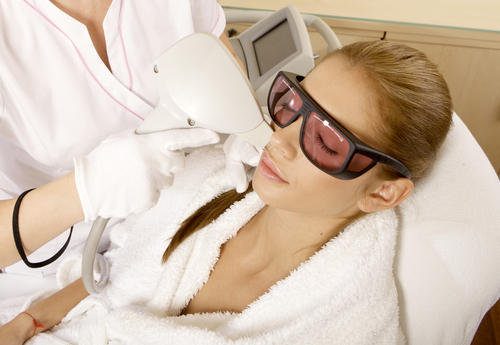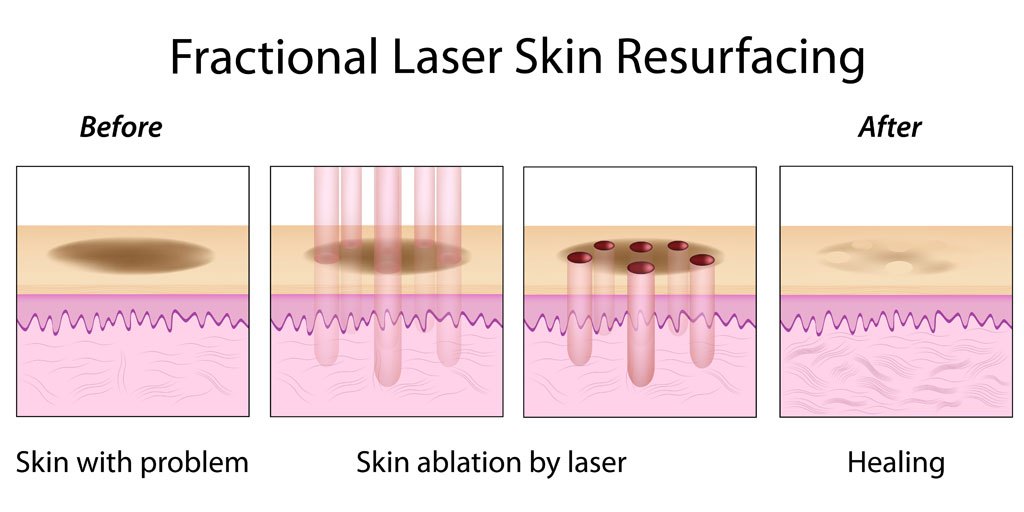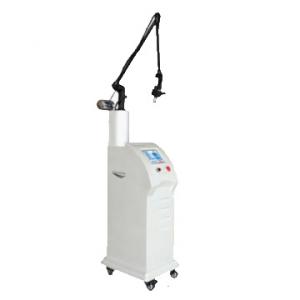
Advances in laser technology have lead to a major increase in demand for cosmetic laser procedures and laser resurfacing. Courtesy of Allen Financial Group.
Cosmetic Laser Industry
One of the most common uses for lasers in cosmetic applications is treatment of scars and wrinkles. The laser aesthetic market offers patients a noninvasive way to solve their skin imperfections through the process of laser resurfacing. Lasers are now able to operate at many different wavelengths and in many different configurations, allowing patients to receive a better personalized treatment for the skin concerns. The rapid advancement in laser technology has proven to be gainful for the market, which has doubled in size since the 1990s. The global cosmetic laser market is projected to surpass $1.2 billion by 2021.

An illustration of the process of fractional laser resurfacing. Courtesy of G Spa.
Types of Laser Resurfacing Treatments
Skin consists of three layers: the epidermis, dermis, and subcutis. Formerly, laser treatment for scars and wrinkles was either ablative or non-ablative based on the depth of the skin concern. The ablative technique uses a laser to vaporize the affected tissue and remove the epidermis. Non-ablative treatment keeps the epidermis in place while heating the effected tissue and stimulating new collagen production.
Today, fractional laser resurfacing (FLR) bridges the gap between non-ablative and ablative treatments. FLR uses short and concentrated beams of light to remove irregularities in the skin while leaving the surrounding tissue unaffected. This technique targets the epidermis and dermis with a beam consisting of thousands of small but deep columns of light. Each column creates a zone for treatment. Old epidermal cells are ejected and collagen is stimulated within each treatment zone. Fractional laser resurfacing treats each zone intensively while leaving the surrounding tissue intact so that the skin is able to help heal itself. While FLR is applicable to any part of the body, it is particularly useful on the chest, neck, and hands.
Evolution of Laser Resurfacing Techniques
Soon after their discovery in 1964, CO2 lasers became the first lasers used in treating unwanted scars and wrinkles. Dermatologists most often used them in continuous mode to remove the epidermis and a portion of the dermis. Physicians found, however, that this intense ablative technique often caused painful side effects and at times loss of skin pigmentation. Researchers then proposed the use of Er:YAG laser, which has a higher absorption coefficient for water and should therefore be better received by the skin. Treatments still required week long recovery times despite the laser being less powerful than the CO2.
The industry then turned to non-ablative techniques with near-infrared wavelength lasers. The potassium titanyl phosphate (KTP) and pulsed dye (PDL) lasers were the most popular. Though their wavelengths allowed them to be effective in treating issues of pigment, they were only minimally effective in skin rejuvenation. The concept of fractional thermolysis was then introduced in 2003 as a method to produce ablative resurfacing results with the minimal recovery period of non-ablative treatment.

The CO2 fractional laser system provides powerful results while minimizing heat damage. Courtesy of GTO Science and Technology.
Laser Resurfacing Treatment Today
Fractional laser resurfacing (fractional thermolysis) is the modern standard for treating scars and wrinkles. Such treatments can be classified as non-ablative and ablative fractional thermolysis systems. The first fractional thermolysis (FT) device is a non-ablative system known as Fraxel. Fraxel operates at 1550 nanometers and stimulates collagen to improve skin texture. While non-ablative FT procedures are effective and minimally invasive, complete results typically require 4-6 treatments. Ablative FT treatments are then best for more severe skin conditions, as they operate with a more intense light. The ablative systems typically consist of either CO2, Er:YAG, or YSGG lasers. These systems are further classified based on the way in which they emit light. Ablative fractional thermolysis systems can have a penetration depth ranging from superficial to deep.
The Future of the Cosmetic Laser Market
Physicians are able to shine maximum power onto scars or wrinkles while causing minimal side effects by emitting short and targeted light pulses. Laser skin resurfacing greatly improves signs of aging and any unwanted scar or blemish. The cosmetic laser market will continue to grow as advances in laser technology allow for better control over devices. The industry now looks to take over superficial cosmetic procedures. 45% of patients considering cosmetic procedures choose skin tightening. Most will opt for laser resurfacing due to the minimal invasion, shorter recovery time, and notably improved results. The increased demand for fractional laser systems leads to a projected 15% growth in the total U.S. market for aesthetic laser devices. Patients will continue to turn to laser treatment for solving their imperfections as procedures become cheaper and easier.

[…] ← Previous […]